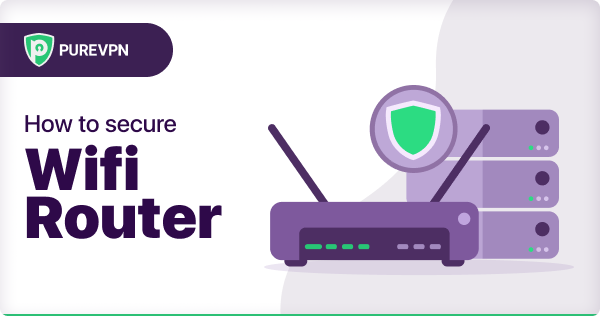
You must be wondering, “Is wifi secure?” In basic terms, a WiFi secure network is such that requires a connection from an internet access point, such as a cable from your internet service provider and integrating it with your router for multiple devices to connect to your home wireless network.
In almost all cases, a wireless network’s router is placed in your home that allows wireless signals to reach out to the ends of your home, and once its setup, just forget about it. As long as our devices our connected to the internet then there is no problem at all.
A router is one of the most important devices of our home. A router is a gateway towards having internet access and, also allowing cybersecurity attackers to exploit any system or network through it. In the fast-paced world of digital technology we live in, data breaches, ransom attacks, and other cybersecurity threats are imminent. Thus, it makes it highly imperative to take some serious countermeasures into implementing some wireless security.
The only security measure that we implement is by setting a WiFi password to just stop neighbors from utilizing your precious bandwidth, but that isn’t the end of the story. A serious risk is that by not having those extra levels of secure home network security, criminals can take huge advantage of this situation and launch exploits on to your system or wireless network and thus, compromise security overall.
These cybersecurity hackers can listen to your network traffic over the air and execute malicious attacks such as man in the middle, identify theft, data breaches, and many others.
Though it is very easy to set up and access your wireless network, WiFi network aren’t always secure networks. Your home WiFi security comes with a lot of issues, and it’s worth considering about the Krack weakness found in the WAP2 (wireless access point protocol 2), that affected all the devices connected through this protocol. Consequently, it has become crucial to be aware of how to secure WiFi connection against cybercriminals is a smart move to consider. No matter how much internet of things you have, but always consider making your network connection extremely safe no matter how tedious it might get to build the boundary.
In this blog, you will know how to implement security practices used to build your security like fort Knox and mitigate the chances of your data getting into the wrong hands.
Change the name of your default home network
If you want to start implementing secure strong network security, the first advisable thing would be to change your WiFi name, also known as the SSID (service set identifier). Giving a WiFi name that’s a bit provocative can sometimes backfire but using any random sentence for your Wireless routers would be highly acceptable. Naming your Wireless network with your name is not feasible since that would disclose the name to cybercriminals.
Changing the WiFi name from the default makes it difficult for malicious attackers to know what kind of router you own. Since routers information such as the manufacturer name, serial number, router type, and other attributes can slip directly into the hacker’s hands. Also, disclosing too much personal information over your network isn’t recommended since that may expose you to identity theft.
Make sure you set a strong and unique password (include symbols, upper and lowercase letters)
You probably would already have an idea that your router comes with a default user name and password attached to it. But sometimes users fail to change the password since they find it too much of a tedious task to do. Not modifying your default password can be a serious threat to you since hackers can easily guess it, especially if they are aware of the manufacturer.
So ensure that you change them both immediately. A strong WiFi password should be lengthy and consist of variations of numbers, symbols, upper and lowercase letters, making it difficult for unethical hackers to guess it. Though your friends might complain of keeping a lengthy password, this might divert them away from utilizing your data
Adding network encryption to your wireless network
Wireless networks come with different encryption languages, such as WEP, WPA(), and WPA2. To have a better understanding of these technologies, WPA2 stands for WiFi Protocol Access 2 that is both a networking protocol and a standard to provide internet access. WPA2 type networks are found almost anywhere and encrypt online network traffic.
It’s also a replacement of WEP (wireless equivalent privacy) and an upper version of the original WPA. Since 2006, all WiFi networks follow the WPA2 protocol. WPA2 AES is a standard security protocol, so all networks can work with it.
The great news is that WPA3 has been introduced as the predecessor of WPA2. The WiFi alliance has come up with new security measures with its new technology that can solve a common security issue: open WiFi networks. Moreover, it also comes with added security improvements, making it easier for internet service providers and users to configure.
Turn of the wireless network when not at home
Though this may seem as rudimentary to some people, shutting off your WiFi devices to increase your wifi security when not at home can mitigate even the smallest chances for hackers to crawl into your network. By doing this, you are closing all ways for hackers to perform malicious exploits while you are away. There are some other benefits why switching of your routing device can be a better choice
1. Security reasons – switching off your devices when away, make sure that you can you out of being a target for hackers
2. Surge protection – when you turn off your router, you are also mitigating the risk of having a power surge
3. Noise reduction– through most routers that come today are extremely quiet, disabling your WiFi network can make add a lot of peacefulness in your home network.
Where is the router located in your home?
You’ve probably never paid attention to the location of your router at home, but where you place your laptop at home can also have a great impact on security. It is advisable to place your router at the center of your home network because positioning it at the center allows router signals to spread evenly at every corner of your house.
Secondly, you don’t want to allow your signals to reach out of your home, where it can easily be infiltrated by hackers. For this reason, it is recommended not to place your router near windows since there is nothing you can do to block router signals.
Use strong WiFi administrator password
To configure a wireless router, you might need to log in to a network portal to access some of the router’s settings. Most WiFi settings come with default credentials such as username and password that makes it easier for hackers to crawl to your system.
The number of wireless networks has increased by multiple folds in 8 years to approximately 400 million. The increase of technical devices such as smartphones, tablets. Laptops and others are responsible for such a drastic increase, and because of how costly data plans are, most people choose to connect their devices to wireless connections.
Change your default IP address
Selecting a different IP address than the one you have at default is a good way to keep your network safe, making it difficult for hackers o track it. To update the IP address of your router, you should follow the steps stated below
1. Log on to your routers console portal as an administrator
2. Once you are there, enter the credentials
3. Then select Network and head to LAN that is in the menu of the left side
4. Change the IP address you prefer, and click save
Turn of DHCP functionality on your router
To improve wireless security, you should switch off the DHCP server in your router that is what IP addresses are placed on to each network. Besides, you should use a static IP address and enter network configurations into your router.
Disable Remote Access
Most routers allow you to access the interface only from a wired device. However, some allow connecting the network remotely. Once you’ve switched off remote access, remote hackers won’t be able to access your network from devices not connected to your internet connection. To alter settings, access the web interface and search for remote access or remote administration that should help you to toggle remote access on/off.
Always keep your router software up to date
Software is an imperative part of your network security. Your wireless router, like any other device, contains some flaws that can make your system vulnerable against cyber-attacks who can ruthlessly launch exploits towards any system or network through payloads, ransomware, MTM (Man in the middle attacks).
Unfortunately, the drawback of every router is the incompetency to update software automatically, so you have to go through the hassle by yourself manually. The importance to keep your new firmware up to date is by no arguments, imperative to shut those open doors for attackers who are constantly trying to bypass your network security and cause you harm.
Pro tip: You should secure your network – Wi-Fi network, network name, username and password with a secure password. A secure Wi-Fi network means you’ll have a secure online experience. Wireless routers are an easy target for hackers and alike, make sure you have AES 256-bit encryption backing your online activities.
A secure Wi-Fi network is of essential importance in today’s highly surveillance world. Make sure to update your passwords and network name to repeatedly spoofing hackers and other cybercriminals.



